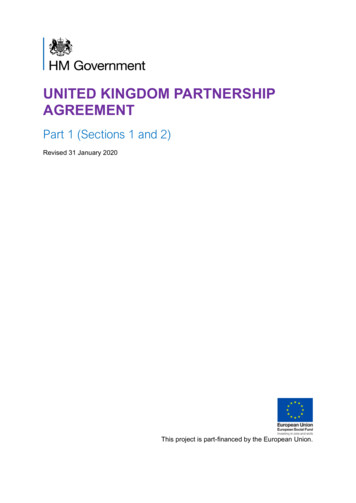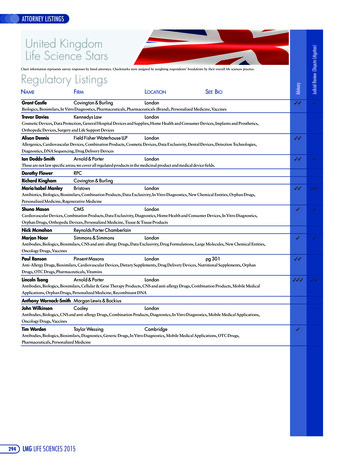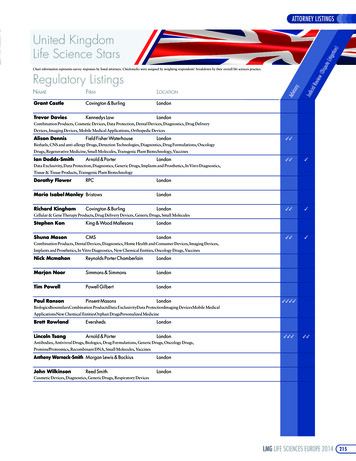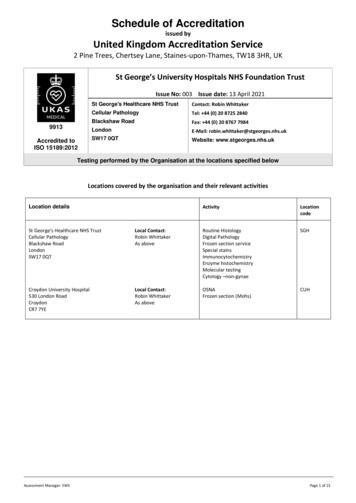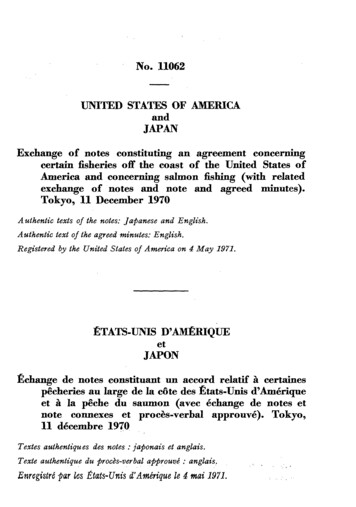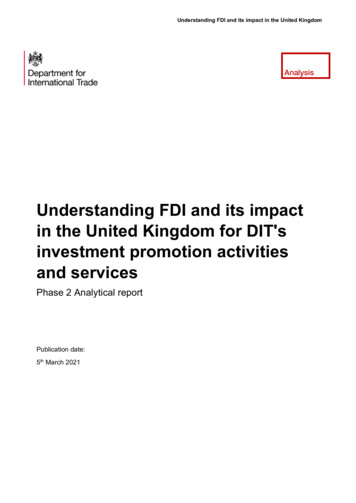
Transcription
Understanding FDI and its impact in the United KingdomUnderstanding FDI and its impactin the United Kingdom for DIT'sinvestment promotion activitiesand servicesPhase 2 Analytical reportPublication date:5th March 2021
Understanding FDI and its impact in the United KingdomSummaryThis report builds on the first phase of DIT’s analysis to further explore how inward FDI affects theBritish economy.DetailsThis analytical report further develops DIT’s understanding of how inward FDI affects the Britisheconomy, which is a vital step in realising DIT’s vision of a value-driven investment promotionstrategy. The report develops a good understanding of distribution of FDI activities in the UKregions. Building on the first phase of DIT’s analysis, the updated methodology estimates theeconomic impact using employment created by Foreign Direct Investment in the UK, which will bereferred to hereafter as ‘foreign employment’ as a measure of FDI to reflect changing industrialcomposition. It also enhances the model’s ability to capture the economy wide impacts of FDI onGross Value Added (GVA).Research Authors:Anuj Joshua Mathew, Kenneth Koo, Emma Hatwell, Miles Johnson, Sami Hamroush, MatthewNeedham and Tord Johnsen (Department for International Trade).Acknowledgements:The analysis covered in the report was undertaken in partnership with London Economics, and theauthors would like to acknowledge the analytical contributions of Laura Koch and Patrice Muller.The Department expresses gratitude to Professor Davide Castellani for peer reviewing the analysisand for his insightful comments and guidance on the analysis.ONS DisclaimerThis work contains statistical data from ONS which is Crown Copyright. The use of the ONSstatistical data in this work does not imply the endorsement of the ONS in relation to theinterpretation or analysis of the statistical data. This work uses research datasets which may notexactly reproduce National Statistics aggregates.2
Understanding FDI and its impact in the United KingdomContentsTable of ContentsMain Points6Executive summary7Section 1: Introduction91.1 Foreign direct investment91.2 Measuring FDI in the UK101.3 Distribution of FDI in the UK111.4 DIT and FDI in the UK15Section 2: A New Measure of FDI162.1 Analysing the economic impact of FDI16Section 3: Economic impact factors183.1 Gross value added (GVA)183.2 Employment183.3 Average wages193.4 Apparent labour productivity (ALP)19Section 4: Analytical approach214.1 Methodology214.1.3 Inter-sectoral GVA impacts methodology24Section 5: Data sources285.1 Data for measures of FDI285.2 Data for impact and Control Measures295.3 Data Transformation295.4 Evaluation Series29Section 6: Results306.1 Overview of model estimates306.2 Evaluation336.2.1 Sectoral approach33Section 7: Application of methodology to projects supported by DIT387.1 Identifying eligible FDI transactions387. 2 Estimating GVA from DIT supported FDI transactions38Section 8: Conclusion398.1 Summary398.2 Limitations and further research393
Understanding FDI and its impact in the United KingdomAnnexes46Annex A – FDI Breakdown into NUTS2 Regions46Annex B – Baseline Econometric estimates48Annex C – Criteria for FDI project54FiguresFigure 1 – Spatial Distribution of UK FDI11Figure 2 – Foreign-owned MNE activity as a percentage of total activity by Region (NUTS1),201812Figure 3 – Methodology for Intersectoral impacts26Figure 4 – Capital Labour ratios34Figure 5 – Evaluated impact of an increase in FDI on GVA36Figure 6 – Evaluated impact of an increase in FDI on Employment37Figure A1 – Foreign-owned MNE activity as a percentage of total activity by Region (NUTS2),201847TablesTable 1 – Estimated coefficients30Table 2 – Sector-specific evaluated results35Table A2 – GVA: baseline econometric estimates - Employment49Table A3 – GVA: baseline econometric estimates - Capital50Table A4 – Employment: baseline econometric estimates - Capital51Table A5 – Average annual wages: baseline econometric estimates - Employment52Table A6 – Average annual wages: baseline econometric estimates - Capital53Table A7 – ALP: baseline econometric estimates - Employment54Table A8 – FDI project eligibility tests55Table A9 – FDI project verification test554
Understanding FDI and its impact in the United KingdomEquationsEquation 1 – Econometric specification22Equation 2 – Evaluation equation for Great Britain23Equation 3 – Sector-specific evaluation equation23Equation 4 – Inter-sectoral: Input sector proportions25Equation 5 – Inter-sectoral: Incremental Ouptut25Equation 6 – Inter-sectoral: Incremental Demand25Equation 7 – Inter-sectoral: Incremental GVA Change25Equation 8 – Inter-sectoral: Total Inter-sectoral GVA Impact in Sectoro26Equation 9 – Inter-sectoral: Total GVA Impacts265
Understanding FDI and its impact in the United KingdomMain Points1. The first phase of DIT’s FDI impact analysis, published in 2018, sought to identify how, whenand where the positive impacts from inward FDI occurs in order to effectively streamline andtarget DIT’s FDI related activities in those sectors where the economic impact is highest.2. Whilst the above report focused solely on the impact of FDI as measured by capitalexpenditure of the foreign investment, in the current report, we also estimate the economicimpact using employment by foreign firms as a measure. This additional measure is developedin recognition of changing nature of foreign investments with certain industries evolving to bemore physical asset-light in nature and increasing prominence of intangible forms of businessinvestments. These changes, along with the emergence of digital economy have enhanced thenewfound ability of firms to access the international market with a much smaller “asset footprintlocally.3. Furthermore, whilst the first phase focused mainly on the impacts within the sector FDIoccurred, in the current report we have enhanced the model to also capture the economy wideimpacts for Gross Value Added (GVA). This wider impact estimation enables a holisticunderstanding of the impact of foreign investment in the economy through supply chain effects.4. Our analysis shows that, overall a 1% increase in FDI stock in Great Britain has on averageresulted an increase in GVA of 0.094% via the capital measure and 0.24% via the employmentmeasure; an increase in employment of 0.084%; an increase in average annual wages of0.045% via capital and 0.11% via employment and an increase in labour productivity of0.031%. Where earlier analysis was undertaken in a similar scope, we see that our results arebroadly consistent and comparable.5. Translating the coefficients for GVA and employment for operational purpose so as to supportpublic policy, on average a 1 million FDI project into Great Britain leads to a net increase innational levels of GVA of around 98,000 and a net increase in employment of around 2.9 jobs.Similarly, translating the employment-based coefficient, we see that a unit increase inemployment at a foreign firm produces an increase in GVA of 212,000.6. Applying this analysis, for the financial year 2019 to 2020, where DIT supported 1,449 FDIprojects, it is estimated that these FDI projects generated approximately 2.8 bn of GVA overthe next three years.7. The report’s analytical findings will be applied to be an enabling guide for DIT to target projectswith the highest predicted economic impact value and to estimate and report the long-termpotential impact of FDI A further application of the analytical finding is to inform thedevelopment of departmental performance metrics in FDI with a focus on economic impact andvalue addition to support internal and external reporting of DIT’s performance in FDI.8. The report also explored the spatial distribution of foreign-owned multinationals across the UKto better understand their contributions to local economies in the UK. Our analysis shows that,while just 4% of local business units in the UK were foreign owned in 2018, they accounted fornearly 40% of UK business turnover and employed 4.9 million people. Furthermore, while theactivities of foreign multinationals are concentrated in certain regions, they accounted forbetween 12% and 21% of local business employment in all twelve regions of the UK.6
Understanding FDI and its impact in the United KingdomExecutive summary1. The analytical report builds on our first phase analysis to further explore how inward FDI affectsthe British economy. This is a vital step in realising DIT’s vision of a value-driven investmentpromotion strategy. By identifying the nature of the economic value in FDI, the report providesa basis to develop a coherent and value-based investment promotion strategy.2. The first phase of our FDI impact analysis focused solely on the impact of FDI as measured bycapital-based foreign investment. In this update we include an employment-based measure ofFDI, so as to estimate the impact of an increase in employment by foreign firms. This is due tothe changing nature of investments as certain industries are evolving to become more assetlight in nature. These changes have enhanced the newfound ability of firms to access theinternational market with a much smaller “asset footprint locally.3. Further, in conjunction with other additions to the Economic Impact Framework, we undertakeanalysis capturing inter-industry impacts on Gross value addition (GVA). This is to developfurther understanding of the broader impacts, as opposed to the previous values whichconcentrate on intra-industry (within the FDI sector) impacts.4. The overall impact of FDI is two-fold, including both direct and an indirect impacts. Thisanalysis focuses on the effects on existing firms in Great Britain, rather than the effect that thenew entrant has on the economy directly. While the analysis focuses on Great Britain, it’sresults are also applicable to the UK due to the small difference in total investment.5. We find that inward FDI has a net positive effect on Great Britain’s economy. At a nationallevel, we find that FDI improve all four of our key economic impact factors. A 1% increase inFDI in Great Britain, on average results in an increase in GVA of 0.094% via the capital and0.24% via the employment measures. An increase of 1% in FDI capital increases employmentand annual wages by 0.084% and 0.045% respectively, and a 1% increase in FDI employmentincreases annual wages by 0.11%. Finally we also found that a 1% increase in FDIemployment increases labour productivity by 0.031%.6. We then translate the coefficients for GVA and employment for operational purposes so as tosupport public policy. On average a 1 million FDI project into Great Britain leads to a netincrease in national GVA of around 98,000 (including inter-sectoral impacts). It also leads toa net increase in employment of around 2.9 jobs. Similarly, translating the employment-basedcoefficient, a unit increase in employment at a foreign firm produces an increase in GVA of 212,000 (including inter-sectoral impacts). Where earlier analysis was undertaken in a similarscope, we see that our results are broadly consistent and comparable.7. The analysis provides justification for the department’s commitment to the value-driveninvestment promotion strategy, by establishing in specific terms the value-adding properties ofFDI. The estimates of impact across sectors allows for directed policymaking, designed tomaximise the impact of investment promotion through identification of high-value areas orindustries.8. Our analysis now offers a more comprehensive overview of how changes in inward FDI affectthe economy due to enhancements since Phase 1. However, there are still some limitationsand possible future extensions worth noting: Our current analysis is unable to identify varying impacts of FDI based on the type ofinvestment, for example, greenfield, brownfield, M&As and expansions. We are also unable7
Understanding FDI and its impact in the United Kingdomto distinguish the regional British impact of FDI and variations within. Work is currentlyunderway to develop our understanding in both these areas. Current analysis only looks at the effect of FDI on Great Britain due to data availability.Additionally, the ARDx data used has not been updated beyond 2014 by ONS. Our evaluation method currently assumes that the relationship between FDI and theeconomic impact variables discussed is same for each sector. When translating for operational purposes so as to support public policy, the method ofdeciding the appropriate FDI measure for each sector is rudimentary. Further developmentof our sectoral understanding will allow us to adapt these allocations as needed. The inter-sectoral impacts assume that firms that receive FDI would operate in the sameway as domestic firms. This approach of assuming the same level of technology for bothdomestic and foreign firms is expected to be conservative estimation of the impact. This isdue to businesses receiving foreign investment tend to be more productive than domesticbusinesses 1. The current analysis assumes the interactions between the sectors have a constant rate ofreturns to FDI. The level of input from other sectors may not scale directly with increasedoutput in the FDI sector. As highlighted within the methodology, the inter-sectoral analysis is based on data from2016, which is the latest data available. The inter-sectoral impacts are most applicable to averages. This means this might be notappropriate for specific businesses. Further detail on limitations are included in the report and we intend to address some ofthese issues in further phases of the analysis.9. Given the limitations of the model and the continued work to improve on it, the analysis and theresults should be treated as experimental in nature.10. The analysis also explored the spatial distribution of foreign-owned multinationals and theiractivities across the UK to better understand their contributions to local economies. Ouranalysis shows t
This is a vital step in realising DIT’s vision of a valuedriven investment - promotion strategy. By identifying the nature of the economic value in FDI, the report provides a basis to develop a coherent and value-based investment promotion strategy. 2. The first phase of our FDI impact analysis focused solely on the impact of FDI as measured by capital-based foreign investment. In this .
